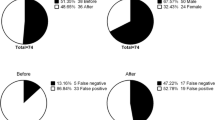Abstract
Brush cytology has previously been described as a feasible method for accurately diagnosing colorectal cancer. PURPOSE: This study was designed: 1) to determine the sensitivity and specificity of brush cytology for the diagnosis of rectal cancer; 2) to prospectively assess the extent of interobserver variability with this technique; 3) to prospectively examine the cost impact of the addition of brush cytology as a routine method of confirming the diagnosis of rectal cancer. PATIENTS AND METHODS: Three hundred fiftyseven patients who attended a rectal clinic and who were found to have a lesion between January 1990 and March 1996 were assessed. Each patient underwent rigid proctoscopy, followed by brush cytology and tissue biopsy. Results were compared with the final histologic diagnosis in each patient. The brushings from the last 92 consecutive patients in this series were independently examined by four cytologists and a pathologist to determine the rate of interobserver variability. RESULTS: Rectal adenocarcinoma was confirmed from surgically resected specimens in 303 patients. Brush cytology accurately diagnosed 278 of them. Of the remaining 25 patients, two had brushings that were insufficient for diagnosis. There was one false-positive case. Forceps biopsy correctly identified cancer in 260 patients, with no false-positive interpretations. Brush cytology accurately identified 53 of 54 adenomas as being benign, and forceps biopsy correctly identified all as benign. Sensitivity of brush cytology in this series was 92 percent, with a specificity of 92 percent. Interobserver agreement was 84 percent. Actual costs incurred with this method was an additional $17.00 per patient. CONCLUSIONS: Brush cytology can accurately diagnose rectal cancer in a high proportion of patients. Interobserver variation is low and compares favorably with other forms of cytologic interpretation. The additional cost remains a concern but can be kept within acceptable proportion.
Similar content being viewed by others
References
Bedine MS, Cocco AE. A comparison of washing and brushing cytology and biopsy in the diagnosis of malignant disease of the esophagus, stomach, and colon. Gastrointest Endosc 1972;19:75–6.
Bemvenuti GA, Prolla JC, Kirsner JB, Reilly RW. Direct vision brushing cytology in the diagnosis of colo-rectal malignancy. Acta Cytol 1974;18:477–81.
Winawer SJ, Leidner SD, Hajdu SI, Sherlock P. Colonoscopic biopsy and cytology in the diagnosis of colon cancer. Cancer 1978;42:2849–53.
Mortensen NJ, Eltringham WK, Mountford RA, Lever JV. Direct vision brush cytology with colonoscopy: an aid to the accurate diagnosis of colonic strictures. Br J Surg 1984;71:930–2.
Jeevanandam V, Treat MR, Forde KA. A comparison of direct brush cytology and biopsy in the diagnosis of colorectal cancer. Gastrointest Endosc 1987;33:370–1.
Chen YL. The diagnosis of colorectal cancer with cytologic brushings under direct vision at fiberoptic colonoscopy: a report of 59 cases. Dis Colon Rectum 1987;30:342–4
Ehya H, O'Hara BJ. Brush cytology in the diagnosis of colonic neoplasms. Cancer 1990;66:1563–7.
Marshall JB, Diaz-Arias AA, Barthel JS, King PD, Butt JH. Prospective evaluation of optimal number of biopsy specimens and brush cytology in the diagnosis of cancer of the colorectum. Am J Gastroenterol 1993;88:1352–4.
ASGE Statement. Tissue sampling and analysis. Gastrointest Endosc 1991;37:663–5.
Silcocks PB. Measuring repeatability and validity of histological diagnosis—a brief review with some practical examples. J Clin Pathol 1983;36:1269–75.
Farouk R, Edwards J, MacDonald AW,et al. Brush cytology for rectal cancer. Br J Surg 1996;83:1456–8.
Siegel M, Barkin JS, Rogers AI, Thomsen S, Clark R. Gastric biopsy: a comparison of biopsy forceps. Gastrointest Endosc 1983;29:35–6.
Danesh BJ, Burke M, Newman J, Aylott A, Whitfield P, Cotton PB. Comparison of weight, depth, and diagnostic adequacy of specimens obtained with 16 different biopsy forceps designed for upper gastrointestinal endoscopy. Gut 1985;26:227–31.
Yang R, Vuitch F, Wright K, McCarthy J. Adequacy of disposable biopsy forceps for gastrointestinal endoscopy: a direct comparison with reusable forceps. Gastrointest Endosc 1990;36:379–81.
Nicholson S, Sainsbury JR, Wadehira V, Needham GK, Farndon JR. Use of fine needle aspiration cytology with immediate reporting in the diagnosis of breast disease. Br J Surg 1988;75:847–50.
Brown LA, Coghill SB, Powis SA. Audit of diagnostic accuracy of FNA cytology specimens taken by the histopathologist in a symptomatic breast clinic. Cytopathology 1991;2:1–6.
Ismail SM, Colclough AB, Dinnen JS,et al. Observer variation in histopathological diagnosis and grading of cervical intraepithelial neoplasia. BMJ 1989;298:707–10.
Lessells AM, Beck JS, Burnett RA,et al. Observer variability in the histopathological reporting of abnormal rectal biopsy specimens. J Clin Pathol 1994;47:48–52.
Nichols ML, Quinn FB Jr, Schnadig VJ,et al. Interobserver variability in the interpretation of brush cytologic studies from head and neck lesions. Arch Otolaryngol Head Neck Surg 1991;117:1350–5.
Author information
Authors and Affiliations
Additional information
Read at the meeting of The American Society of Colon and Rectal Surgeons, Seattle, Washington, June 9 to 14, 1996.
About this article
Cite this article
Farouk, R., Dodds, J., MacDonald, A.W. et al. Feasibility study for use of brush cytology as a complementary method for diagnosis of rectal cancer. Dis Colon Rectum 40, 609–613 (1997). https://doi.org/10.1007/BF02055388
Issue Date:
DOI: https://doi.org/10.1007/BF02055388




